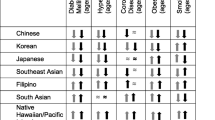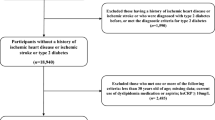Abstract
The primary aim of this study was to evaluate cardio-metabolic burden by insurance status for Hispanic/Latino adults in Santa Barbara, CA. HbA1c, body mass index (BMI), and health insurance status were evaluated via community-based screenings. Cardiovascular (CV) risk was assessed using the Framingham Heart Study calculator and compared with a National Health and Nutrition Examination Survey background population. Of 593 participants (73% female, age 47.3 years (SD ± 15.2), 44.5% had no insurance or did not know if they had insurance. 16% had an HbA1c in the diabetes range, comprised of 9% self-reporting diabetes and 7% self-reporting no diabetes. 39% had an HbA1c in the prediabetes range. Elevated HbA1c was associated with significantly higher BMI (p = 0.003) and lack of health insurance (p = 0.031). 10-year CV risk was significantly higher than the general population (p < 0.001). This program identified a high burden of cardio-metabolic disease and uninsurance coverage in Hispanic/Latino adults in Santa Barbara.



Similar content being viewed by others
References
National Center Health Statistics. Health, United States, 2016: With Chartbook on Long-term Trends in Health. Hyattsville: Centers for Disease Control and Prevention; 2017.
Mozaffarian D, Benjamin EJ, Go AS, et al. Heart disease and stroke statistics-2016 update: A report from the American Heart Association. Circulation. 2016;133:e38–60.
Aviles-Santa ML, Colon-Ramos U, Lindberg NM, Mattei J, Pasquel FJ, Perez CM. From Sea to Shining Sea and the Great Plains to Patagonia: a review on current knowledge of diabetes mellitus in Hispanics/Latinos in the US and Latin America. Front Endocrinol (Lausanne). 2017;8:298.
Beydoun MA, Beydoun HA, Mode N, et al. Racial disparities in adult all-cause and cause-specific mortality among us adults: mediating and moderating factors. BMC Public Health. 2016;16:1113.
Fisher-Hoch SP, Vatcheva KP, Rahbar MH, McCormick JB. Undiagnosed diabetes and pre-diabetes in health disparities. PLoS ONE. 2015;10:e0133135.
Gellad WF, Haas JS, Safran DG. Race/ethnicity and nonadherence to prescription medications among seniors: results of a national study. J Gen Intern Med. 2007;22:1572–8.
Golden SH, Brown A, Cauley JA, et al. Health disparities in endocrine disorders: biological, clinical, and nonclinical factors–an Endocrine Society scientific statement. J Clin Endocrinol Metab. 2012;97:E1579–E16391639.
Canedo JR, Miller ST, Schlundt D, Fadden MK, Sanderson M. Racial/ethnic disparities in diabetes quality of care: the role of healthcare access and socioeconomic status. J Racial Ethn Health Disparities. 2018;5:7–14.
D'Agostino RB Sr, Vasan RS, Pencina MJ, et al. General cardiovascular risk profile for use in primary care: the Framingham Heart Study. Circulation. 2008;117:743–53.
Bitton A, Gaziano TA. The Framingham Heart Study's impact on global risk assessment. Prog Cardiovasc Dis. 2010;53:68–78.
National Center for Health Statistics. National Health and Nutrition Examination Survey 2013–2014. U.S. Department of Health and Human Services, Centers for Disease Control and Prevention, Hyattsville
American Diabetes Association. Standards of medical care in diabetes-2017 abridged for primary care providers. Clin Diabetes. 2017;35:5–26.
Schneiderman N, Llabre M, Cowie CC, et al. Prevalence of diabetes among Hispanics/Latinos from diverse backgrounds: the Hispanic Community Health Study/Study of Latinos (HCHS/SOL). Diabetes Care. 2014;37:2233–9.
Davidson MB, Duran P, Lee ML. Community screening for pre-diabetes and diabetes using HbA1c levels in high-risk African Americans and Latinos. Ethn Dis. 2014;24:195–9.
Health CHP. Cottage Health Community Health Needs Assessment Report, 2016. Santa Barbara: Cottage Health; 2016.
Babey SH, Wolstein J, Diamant AL, Goldstein H. Prediabetes in California: nearly half of california adults on path to diabetes. Policy Brief UCLA Cent Health Policy Res. 2016;PB2016-1:1–8.
Barnett JC, Berchick ER. Health Insurance Coverage in the United States: 2016. Washington DC: US Government Printing Office; 2017. p. 60–260.
United States Census Bureau. QuickFacts Santa Barbara County. UNITED STATES: California; 2017.
United States Census Bureau. American Fact Finder. American Community Survey 1-Year Estimates. 2015.
Screening for Diabetes. Diabetes Care. 2002;25:s21–s2424.
Tang TS, Funnell M, Sinco B, et al. Comparative effectiveness of peer leaders and community health workers in diabetes self-management support: results of a randomized controlled trial. Diabetes Care. 2014;37:1525–34.
Creason J, Conneely M, Axelrod C, Bevier W, Swartzentruber J, Kerr D. Ocho Pasos a la Buena Salud (Eight Steps to Better Health)—a Diabetes Education Program for Low-Literacy Latinos With or at Risk for Type 2 Diabetes (T2D). Diabetes. 2018;67(Supplement 1):670.
Acknowledgements
We gratefully acknowledge financial support from Cottage Health, the Towbes Foundation, and the Crawford Idema Foundation. We also thank all of the organizations who hosted MHS events and all staff who conducted the events, especially the Promotores de Salud, who were instrumental in allowing us to reach the local Hispanic/Latino community in a meaningful and culturally competent manner.
Author information
Authors and Affiliations
Corresponding author
Additional information
Publisher's Note
Springer Nature remains neutral with regard to jurisdictional claims in published maps and institutional affiliations.
Rights and permissions
About this article
Cite this article
Axelrod, C., Bevier, W., Yang, B. et al. Real-World Association of Insurance Status with Cardio-metabolic Risk for Hispanic/Latino Adults Living on the Central Coast of California. J Immigrant Minority Health 22, 1049–1054 (2020). https://doi.org/10.1007/s10903-019-00959-6
Published:
Issue Date:
DOI: https://doi.org/10.1007/s10903-019-00959-6




